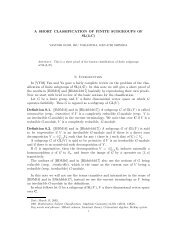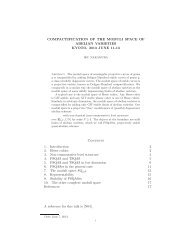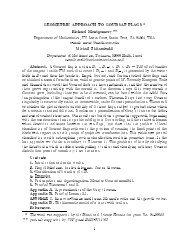mckay correspondence iku nakamura
mckay correspondence iku nakamura
mckay correspondence iku nakamura
- No tags were found...
You also want an ePaper? Increase the reach of your titles
YUMPU automatically turns print PDFs into web optimized ePapers that Google loves.
32 IKU NAKAMURAThen we see p 1 B 1 − ω 2 p 2 B 2 + ωp 3 B 3 = ω(1 − ω)(ψ 2 − ωuϕ). Hence ψ 2 −ωuϕ ∈ I univ , whence ψ 3 −ωuW ∈ I univ . Similarly we see p 1 B 1 −p 2 B 2 +p 3 B 3 =(ω − 1)sW − 3tT, which belongs to I univ . We also have (1 − ω 2 ){(1 + s)ϕ 2 −ωuψ} = p 1 B 1 − ωp 2 B 2 + ω 2 p 3 B 3 ∈ I univ . Hence (1 + s)ϕ 3 − ωuW ∈ I univ .From π ∗ m ∩ I univ = {0} it follows thatIt follows thatπ ∗ ψ 3 = ωuπ ∗ W, (1 + s)π ∗ ϕ 3 = ωuπ ∗ W,(ω − 1)sπ ∗ W =3tπ ∗ T,π ∗ ϕ 3 − π ∗ ψ 3 = 3(2ω +1)π ∗ T 2 .π ∗ W = ω2 u 21+s ,π∗ ϕ 3 =u 3(1 + s) 2 ,π∗ ψ 3 = u31+s ,3π ∗ T =(1− ω 2 u 2 s)(1 + s)t , (1 − ω)su = t2 .Though the relation (1 − ω)su = t 2 looks singular at P (ρ 2 ,ρ 3 ), the points = t = 0 of Hilb G (A 2 ), it is not singular at all because s and t/s are regularparameters at P (ρ 2 ,ρ 3 ).The condition W ≠ S 1 V 5 (ρ 2 ),S 1 V 5 (ρ ′ 2),S 1 V 5 (ρ ′′2) implies s(1 + s) ≠0,s ≠∞. The parameters s, t and u are related by (1 − ω)su = t 2 . Hence π ∗ m =(π ∗ T )=(u 2 /t) =(t 3 ) along E(ρ 3 ) \ Sing(E), whence E fund =3E(ρ 3 ) there.We see mod n XtB 1 = tp 1 (ϕ + ωψ)+stp 1 ϕ + t 2 p 2 p 3 + tup 1= tp 1 (ϕ + ωψ)+stp 1 ϕ + t 2 p 2 p 3 − 3ω(1 + s)p 1 T= −ω 2 (s − ω)p 3 B 2 +(s − ω 2 )p 2 B 3 ,tB 2 = ω(s − ω)p 1 B 3 − (s − ω 2 )p 3 B 1 ,tB 3 = −ω(s − ω)p 2 B 1 +(s − ω 2 )p 1 B 2 .1This proves tB i =0inV. Hence V is S[s, ]-free of rank three. Thiss(1+s)completes the proof of freeness of V over E(ρ 3 ) \ Sing(E) for E 6 .6.2.8. We explain very briefly the most complicated case of E 7 , that is, theρ 4 -case. The finite group G involved is the binary octahedral group O, andthe invariant ring of G is generated by homogeneous polynomials of degree 8,12, and 18, where we note that 18 is also the Coxeter number of E 7 .Any point I = I 4 (W ) ∈ E(ρ 4 ) \ Sing(E) is given by an irreducible G-submodule of V 9 (ρ 4 ) with W ≠ S 1 V 8 (ρ ′′2 ),S 1V 8 (ρ 3 ),S 1 V 8 (ρ ′ 3 ) under the notationof section 5. Then we seeHom S (I/I 2 , S/I) = Hom (W, V 9 (ρ 4 )/W ) ⊕ Hom (W, V 7 (ρ 4 )).The versal deformation I univ is generated over E(ρ 4 ) \ Sing(E) by five elementsB 1 ,B 2 ,B 3 ,B 4 ,A := A 8 − π ∗ (A 8 ), where A 8 = W is the same as W of





